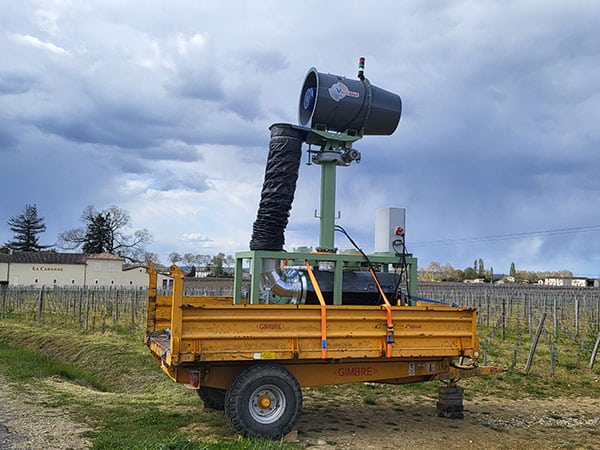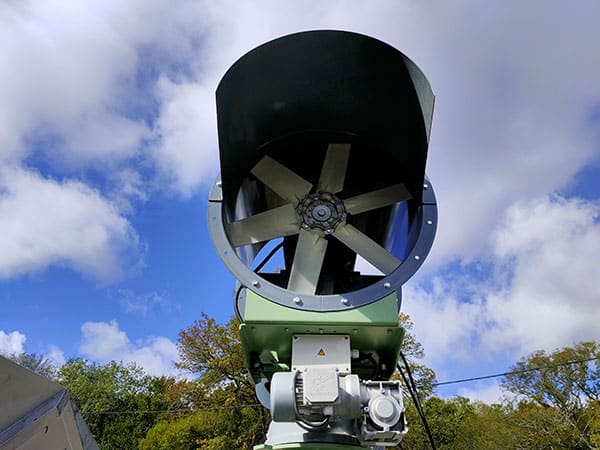Antifreeze towers are air circulation systems used to protect crops against spring frost. In the current climate change context, vegetation is budding earlier and earlier, making the first buds particularly vulnerable to the arrival of cold snaps, right up to the Ice Saints at the beginning of May.
So it’s very important to find effective , economical ways of combating frost. To do this, and depending on the type of frost arriving on the plots, we’ll try to recover the slightly warmer air above (radiative frost). However, when the frost is advective (without a temperature gradient), it is necessary to add calories to the air flow.
Antifreeze tower operation
The anti-freeze tower works on a relatively simple principle. A fan is installed at a height of varying magnitude. The fan may be driven by a heat engine running on oil or gas, or by an electric motor. The fans can be of various lengths and generally number 2 or 3. However, this solution is not without its noise nuisance. The fan can also be a helical turbine with multiple blades.
Typically, antifreeze towers can rotate 360° on themselves to cover concentric surfaces. These rotations can also be reduced, to 180° or even 90°.
The same applies to the horizontal inclination of the frost protection tower, which can be adjusted to suit the topology of the terrain.
Any heat source can be integrated into the frost protection tower, or located nearby.






Materials used in the construction of the anti-freeze tower
Antifreeze towers are usually built using corrosion-resistant materials, such as stainless steel or aluminum, to guarantee a long service life. They can be powered by various energy sources, such as electricity, natural gas or propane.
Antifreeze tower applications in vineyards
The use of anti-freeze towers in vineyards is an effective and long-lasting solution for protecting grapes from low temperatures and bad weather.
Antifreeze towers are ventilation systems that, combined with heating, use air to dry out and bring heat to protected areas, which can be particularly useful in regions with cold, wet winters.
Advantages of the anti-freeze tower
There are many advantages to using antifreeze towers on vines and crops.
Once in place, simply switch it on and leave it running until positive temperatures return to the crops. Start-up can be either manual or automatic. Above all, you need to be equipped with independent temperature measurement systems and sufficiently reliable alarms to ensure that your antifreeze tower is commissioned at the right time.
Also, thanks to their coverage ranging from 2 to 5 acres, the anti-freeze tower solution eliminates the need for costly and time-consuming solutions such as candles (300/acre), heating wires, sprinkler systems (40m3/h/acre) or others.
The use of mobile solutions is recommended, so that anti-freeze towers can be stored away at the end of the frost period. More and more local authorities are introducing measures to reduce ” visual pollution ” in vineyards and crops. What’s more, once stored under cover, the mobile antifreeze tower will be protected from the elements and have an extended lifespan.
Antifreeze towers therefore reduce the risk of production and financial losses for farms.
Conclusion
As winters become milder and milder, plant formation becomes earlier and earlier. As vegetation wakes up earlier and earlier, late frosts, while not necessarily more numerous, are more damaging for growers. Some crops may be able to withstand heavy frosts in January-February because they are in vegetative rest, but suffer damage during much milder frost episodes, in terms of measured temperature, once they are in the bud-break phase, when the buds are much more fragile.
Particularly in the south-west of France, these devastating episodes have multiplied in recent years: 2017, 2019, 2021, 2022. As a result, many farmers cannot afford to suffer the consequences of another event of this type, and are seeking to protect themselves against the risk.
Antifreeze towers therefore offer a simple and effective solution for protecting crops against frost, especially if they are mobile, with an integrated heat booster, and low maintenance. If you’re close to housing, you’ll need to choose the quietest solution.

